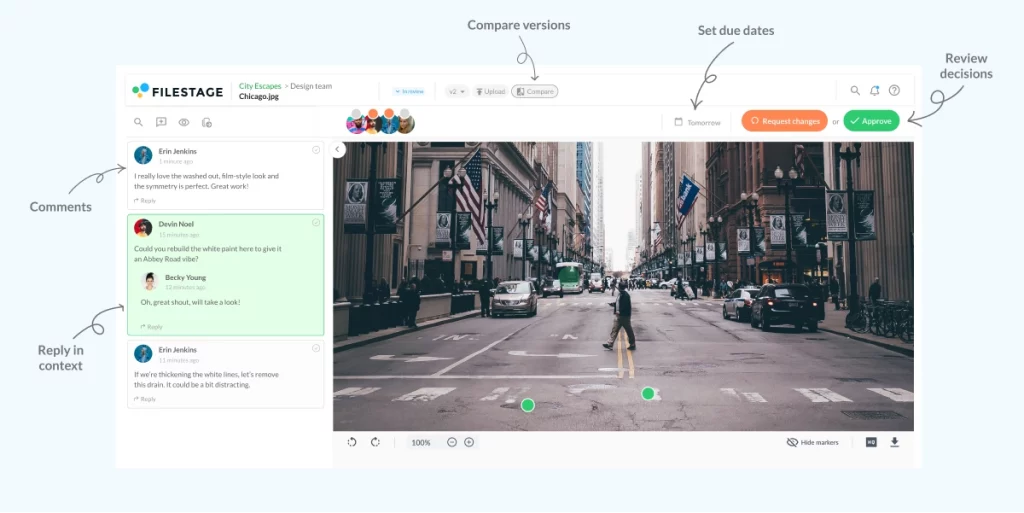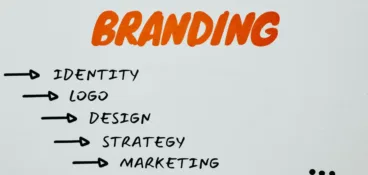Corporate brand management is about so much more than your brand logo and color scheme. These are important, that’s for sure, but brand management extends far beyond the visuals.
It’s about nurturing and protecting your brand identity and the reputation of your company, making sure every interaction – with customers, stakeholders, shareholders, and employees – reflects your core values and mission.
From clearly defining your corporate brand strategy to preparing for crises, corporate brand management is a critical business strategy which ultimately paves the way for long-term success.
In this guide you’ll find seven crucial tactics for managing your corporate brand.
Let’s get started!
1. Define your brand strategy
The first step is to create a clear and comprehensive corporate brand strategy. This includes corporate branding in a visual sense, but on a larger scale it also outlines your brand’s mission, vision, and core values. Your branding strategy acts as the cornerstone of all your branding efforts, guiding every decision you make and shaping how partners and customers perceive your brand across all touchpoints.
Outline your brand’s mission, vision, and values
These key elements lay out exactly what your company stands for. Its beliefs. Its aspirations. Its purpose. They influence every single aspect of your business operations, from your marketing strategies to your internal company culture. They guide decision-making and behavior across the organization – they’re your raison d’etre. Your guiding star.
Sit down with key stakeholders, including your executive team, your board of directors, and department heads to build a cohesive and strong corporate brand identity that reflects your core values and resonates with your target audience.
Craft your visual and verbal brand identity
This part is all about the look and style of your corporate branding, including both visual and verbal elements.
From a visual perspective, your branding strategy includes everything from your company’s brand logo and color scheme to photography style and typography. From a verbal perspective, take time to craft your brand voice – the tone and style of your communication. Your tone of voice should reflect your brand personality and remain consistent across all content, from blog posts and social media content to advertising campaigns and internal comms.
Both your verbal and visual identity should reflect your brand’s personality and core values, and should be developed with your target audience in mind too.
By taking time to craft a strong corporate identity, you lay a solid foundation for building brand loyalty and establishing your reputation in the marketplace.
Supercharge your marketing reviews
Share, review, and approve all your content in one place with Filestage.
2. Keep things consistent across all channels
Now that you have a clear brand strategy in place, the next step is to make sure things stay consistent across all communication channels. Or in other words, maintain your brand governance.
A uniform brand voice and visual identity are essential for reinforcing your brand’s identity and building brand recognition. Consistency also helps to build trust with your audience. When they have a reliable and predictable experience, they’re more likely to stay loyal – and brand loyalty is worth its weight in gold in the corporate world.
Here are some effective ways to maintain brand consistency:
- Create brand guidelines – Develop comprehensive brand guidelines that detail your visual and verbal identity. These should be shared internally for easy reference by the whole company.
- Store assets in a centralized location – Make sure all brand assets are easily accessible to everyone in the organization, like your brand guidelines, logos, templates, and photography. Use a centralized file management system to keep everything in one place and up to date.
- Set up a formal review and approval process – Creating a structured process for reviewing and approving new content before it’s published helps prevent inconsistencies and errors across different platforms.
This last point is where Filestage comes in.
With Filestage, you can create structured approval processes for all content, so that every piece of content is reviewed and approved by the right people before it gets put in front of the public.
Here’s how Filestage can help:
- Customized approval workflows – To ensure every piece of content is reviewed by the right stakeholders
- Workflow automation – To reduce manual tasks and speed up content reviews
- Project dashboards – To help you keep track of who you’re still waiting to hear from
- In-context comments – For clear feedback that shows up in real time
- Version control – To keep versions organized, so that only the most current version is used
- Integrations – With Dropbox, Google Drive, Slack, Microsoft Teams, and more
- 256-bit SSL file encryption – For secure file sharing

3. Streamline collaboration with internal and external teams
The next critical aspect of corporate brand management is streamlining collaboration with both internal and external teams. All internal teams and external partners need to have the tools available to be able to work together effectively. The right brand management software helps keep everyone on the same page, which is not only crucial for consistency in messaging and brand identity, but for fast decision-making and high-quality output too.
Set clear communication channels
Establish clear communication channels so that it’s easy for teams to stay in touch, ask questions, and keep each other up to date. Think about what different teams need so that you can pick the communication channels that are best suited to their ways of working. While email remains a staple for formal and official communications, these days you can pick from a wide range of comprehensive communication tools to streamline other types of communication.
By making it easy for teams to communicate, you reduce the risk of mistakes and misunderstandings which could otherwise be detrimental to your corporate brand.
Invest in effective collaboration tools
Communication tools sorted, now to pick collaboration tools that will help teams work together effectively on everything from marketing projects to customer support. From project management tools like Asana to review and approval tools like Filestage, there are specialist collaboration solutions to suit just about every use case. These tools are designed to help teams collaborate, problem-solve, and innovate, regardless of time zones and geographical boundaries.
4. Prepare your crisis management strategy
Brand crises are inevitable. That’s a fact. Whether it’s a product failure, a PR disaster, a data breach, or inappropriate advertising, these things happen, and they’re somewhat out of your control.
What is in your control is a crisis management strategy. Having a plan in place for when the worst happens means you’re ready to respond swiftly, minimizing damage to your corporate brand image and redeeming your reputation, STAT.
Here’s how to go about preparing your crisis management strategy:
- Assess your risks – Start by conducting a thorough risk assessment to identify potential crises that could impact your organization. Consider everything from data breaches to social media mishaps, and assess how likely each is to happen, plus the potential impact it could have on your business.
- Assemble a crisis management team – Form a dedicated crisis management team, with members from departments such as legal, PR, HR, and operations. Delegate clear roles and responsibilities, and train the team on what to do during a crisis.
- Create detailed response plans – Develop action plans for different types of crises, outlining the steps to take and the resources and personnel needed. Plan how you’ll communicate, including internal comms to employees and external comms to the public, media, and other stakeholders.
- Prepare communication templates – Prepare templates for press releases, social media posts, and other internal and external communications, which can be quickly tailored in a crisis.
- Establish monitoring systems – Implement systems to detect early signs of potential crises, and set up alert systems that immediately notify the right people when a potential crisis is detected.
Once that’s all sorted, you’re ready for whatever’s thrown at you!
5. Manage your online brand reputation
On a somewhat similar note, let’s discuss maintaining your online brand reputation. This includes both proactive strategies and reactive measures to make sure your brand’s digital presence remains positive and engaging, consistently reflecting your core values and resonating well with your audience.
Monitor online mentions
Just like with crisis management (after all, an online disaster is a crisis!), managing your online brand reputation involves monitoring what is being said about your brand online. That includes media attention, as well as discussions on social media platforms, review sites, and forums.
Knowledge is power, so set up Google Alerts to receive notifications whenever your brand name and key executives are mentioned online. And consider using a tool like Hootsuite to track mentions, hashtags, and keywords related to your brand on social.
Respond quickly and thoughtfully
No matter what’s said about your brand online, the key is to respond in a timely and thoughtful manner. If it’s positive feedback, take the time to respond with a thank you. If it’s negative, craft a personalized response that carefully addresses the issues presented. Taking the time to respond shows that you care, and can have a huge sway on brand perception.
Encourage reviews
Building a positive online reputation includes some proactive strategies too, like encouraging satisfied customers (emphasis on satisfied) to leave positive reviews. Other strategies include creating valuable content to show off your brand’s expertise – which we’ll look at in the next section.
6. Engage your audience with compelling content
Another key pillar of a successful corporate branding strategy is consistently engaging your target audience with compelling content – across various channels. From marketing campaigns and advertising campaigns through to social media and blog posts, regularly creating and sharing content helps to maintain brand visibility, build trust and appreciation of your brand value, and establish your brand as a thought leader in your industry.
Here are some of the types of content to consider.
Social media content
Nothing beats social media for building relationships with your audience. It provides the opportunity to reach customers with interesting and engaging content that not only showcases your brand’s personality, but also encourages real-time interactions.
Whether it’s announcing new product launches, hosting live Q&A sessions, or reacting to current events, use social media to connect with your target audience and show that your brand is authentic and relatable, building a sense of community and customer loyalty.

Content marketing
Develop a content marketing strategy that targets every step in the sales funnel – from awareness and consideration through to conversion. From blog posts and landing pages to case studies and even podcasts, think about the type of content that would be most useful to different segments of your target audience. Topics could include everything from your corporate values and your corporate social responsibility initiatives through to industry insights and relevant tutorials.
Advertising campaigns
While organic reach is essential, advertising campaigns allow you to reach specific segments of your target audience with tailored messages. These campaigns should aim to sell, of course, but they should always be in line with your corporate culture and ethics. That way, each campaign reinforces your corporate identity and message.
A fundamental part of the content creation process is review and approval. After all, you don’t want to publish anything that contains any mistakes or anything that could potentially damage your brand. Online proofing tools like Filestage help you set up a clear and standardized review process that every new asset needs to go through before it can be published.
7. Learn from mistakes and successes
The final tactic for effective corporate brand management is to continuously learn from both your successes and your mistakes. An effective corporate branding strategy will adapt and evolve over time – even if it’s perfect to begin with, market dynamics, consumer behavior, and competitive landscapes are always changing, so regular reviews are essential for staying relevant and effective.
Here are some ways to monitor your mistakes and successes as part of your corporate branding efforts.
Audience feedback
Your customers, employees, and partners are your best critics, so listen to their feedback – positive and negative – to see where you’re going right, and where you’re going wrong. Corporate brands that listen to their audience are more likely to build loyalty, have greater customer satisfaction, and foster meaningful connections that drive business success.

Customer behavior and engagement data
As well as feedback, customer behavior and engagement data help you to measure successes and failures too. You can analyze everything from website analytics and sales data to social media analytics and the performance of brand marketing campaigns, and use the results to tailor future campaigns and initiatives.
Competitive analysis
Monitoring your competitors’ marketing activities, product launches, and customer feedback helps you to benchmark your brand against them. This in turn helps you to identify both areas where you have a competitive advantage, and areas of underperformance (or in a more positive light, areas of opportunity).
Final thoughts
Corporate brand management is vital when it comes to nurturing and protecting your brand identity and fostering brand loyalty. A key part of this is making sure messaging is consistent across all channels – and that every piece of content you publish is free from potentially damaging mistakes.
If you’d like to see for yourself how Filestage can help you keep all your assets on brand, you can start a free trial here.








